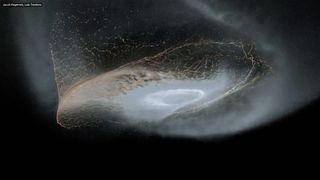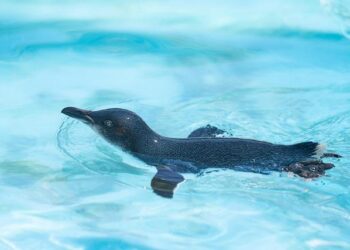News
Science & Astronomy

A collision between two ancient icy moons that may have once orbited Saturn could have given rise to the planet’s iconic ring system, a new study reveals.
(Image credit: NASA)
A collision between two ancient icy moons that may have once orbited Saturn could have given rise to the planet’s iconic ring system, a new study reveals.
Saturn is probably the most eye-catching planet in the solar system, but it may also be one of the most mind-boggling. Surrounded by a series of seven concentric rings and orbited by an army of 245 moons, the gas giant, second in size only to Jupiter, has puzzled astronomers for centuries.
A new study may have found an answer to one of Saturn’s mysteries — the origin of its rings. The study, based on dozens of computer simulations, used data collected by NASA’s Cassini mission that orbited Saturn for 13 years between 2004 and 2017. The probe found the material that makes up the rings, first observed by Galileo Galilei in 1610, consists of icy fragments that are very pristine and unpolluted by dust. Those Cassini findings suggested that the iconic rings of Saturn must be fairly young, only a few million years old, and that for the majority of the solar system’s 4.5 billion-year history, the iconic Saturn looked much more bland.
Related: Saturn’s moon Enceladus has all the ingredients for life in its icy oceans. But is life there?
The researchers behind the new study, a team consisting of experts from NASA and Durham University in the U.K., speculated that the rings may have formed from a relatively recent collision of two ancient icy moons. They used powerful supercomputers to simulate nearly 200 scenarios of such a collision.
The results revealed that a collision between two moons about as large as Saturn’s current moons Dione and Rhea (which have diameters equivalent to one third and a little under a half of Earth’s moon diameter respectively), could explain the existence of those rings.
“We tested a hypothesis for the recent formation of Saturn’s rings and have found that an impact of icy moons is able to send enough material near to Saturn to form the rings that we see now,” Vincent Eke, Associate Professor in the Department of Physics/Institute for Computational Cosmology at Durham University, said in a statement.
Although the rings are made almost purely from ice, scientists think that Saturn’s icy moons have rocky cores. The simulations confirmed that the icy fragments and the rocky bits would scatter in different ways after a collision, allowing the rocks to coalesce into new moons while the ice would get dispersed in orbits closer to Saturn’s surface.
Rings can only form around celestial bodies within the Roche limit, a boundary where the gravity of the orbiting material is weaker than the tidal forces of the body it orbits.
The simulations show that many of the hypothetical collisions would inject a lot of ice into lower altitudes while the rocks would clump together in higher orbits.
“This scenario naturally leads to ice-rich rings because when the progenitor moons smash into one another, the rock in the cores of the colliding bodies is dispersed less widely than the overlying ice,” Eke said.
Saturn’s ice-covered moons are of great interest to scientists as some of them, such as the tiny Enceladus, might harbor conditions suitable for the emergence of life. There is still a lot that scientists don’t know about Saturn and its past, and the results of the study are only a small step toward cracking the planet’s mysteries.
The study was published in The Astrophysical Journal on Sept. 27.
Join our Space Forums to keep talking space on the latest missions, night sky and more! And if you have a news tip, correction or comment, let us know at: [email protected].
Breaking space news, the latest updates on rocket launches, skywatching events and more!
Tereza is a London-based science and technology journalist, aspiring fiction writer and amateur gymnast. Originally from Prague, the Czech Republic, she spent the first seven years of her career working as a reporter, script-writer and presenter for various TV programmes of the Czech Public Service Television. She later took a career break to pursue further education and added a Master’s in Science from the International Space University, France, to her Bachelor’s in Journalism and Master’s in Cultural Anthropology from Prague’s Charles University. She worked as a reporter at the Engineering and Technology magazine, freelanced for a range of publications including Live Science, Space.com, Professional Engineering, Via Satellite and Space News and served as a maternity cover science editor at the European Space Agency.
>>> Read full article>>>
Copyright for syndicated content belongs to the linked Source : Space.com – https://www.space.com/saturn-rings-origin-moon-collision






























